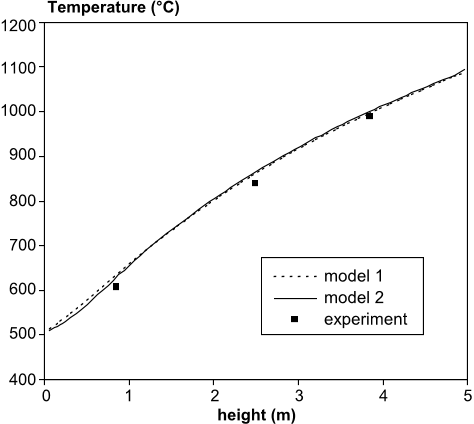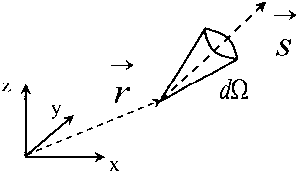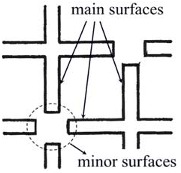A numerical approach for the study of glass furnace regenerators
Summary (3 min read)
1. Introduction
- Regenerators are widely used in many industrial sectors such as cryogenic, metallurgical, chemical process and glass industry.
- Regenerator operation relies on the successive alternation of hot and cold periods.
- Heat exchange is indeed dominated by free turbulent convection mechanisms next to the entrance of the channel whereas, next to the exit, mechanisms of laminar forced convection prevail.
- The closed methods only calculate the cyclic equilibrium and only the periodic conditions are taken into account in the problem.
- That is the reason why the present work proposes an open method, using the Computational Fluid Dynamics (CFD) code Fluent, able to estimate the mean heat transfer coefficients with a satisfactory accuracy.
2.1. General equations
- Its direction is characterized by the unity vector~s and the coordinates are defined by the vector~r (Fig. 2).
- The authors consider an absorbing, emitting and grey medium in which scattering phenomena are negligible.
- Under these assumptions, the radiant transport equation (RTE) can then be written ~s grad !ðLÞ ¼ jI eq jI ð5Þ where Ieq ¼.
- I eqð~rÞ is the equilibrium radiant luminance, given by the Planck s function and j the absorption coefficient.
2.2. Similitude criteria for the cold period
- The dimensionless form of the momentum equation (2) gives rise to two similitude criteria (see Padet [23,24]).
- Dh of the channel and the velocity scale is the mass-flow velocity Um. Moreover, as the hydraulic diameter is constant, the mass conservation equation (1) involves qU = q0U0.
- Two models can be considered to satisfy the similitude criterion on the Richardson number: First model.
- For a buoyancy-driven flow, this model (called model 1) is known to give poorer results than those given with the use of the Boussinesq approximation.
2.3. Similitude criteria for the hot period
- During the hot period, the effect of free convection is negligible so that the buoyancy term gq in the momentum equation (2) no longer exists and as a consequence the similitude criterion for the Richardson number.
- The Peclet number and the Reynolds number are still two similitude criteria and are respected in the same way as in the cold period.
- But, the dimensionless energy equation give rise to a new similitude criterion defined as (the refraction index is equal to unity, n = 1) The Planck number; jk n2rT 3 ð13Þ where r is the Stefan–Boltzmann constant.
- As the dependence of the thermal conductivity with temperature is considered in their models, this similarity criterion will be respected when the absorption coefficient j is correctly taken into account.
- The model WSGG is of great interest thanks to its reduced CPU time and some authors, as Denison and Webb [26], have recently made improvements on it.
2.4. Calculation procedure
- The calculations need an initial temperature condition in the channel: the value (Tc,in + Th,in)/2 is then imposed.
- The transient calculation starts with a hot period followed by a cold period.
- This operation goes on until the cyclic equilibrium is reached.
- For each period, only one step time is made as the evolution of temperature is linear with time and height in the channel [9].
- The typical CPU time was approximately 4 weeks on one processor of a modern multiprocessor SUN powerstation.
3. Test results
- As preliminary work, this section proposes to simplify the problem under consideration by comparing the results of their method to reliable experimental or analytical data from the literature describing each physical phenomenon (free convection, mixed convection, radiation) on a simple geometry (tube, vertical flat plate).
- Thus, the simulation can be made with a two-dimensional grid, contrary to the complete simulation described in Section 5 which is three-dimensional.
- For the cold period, a turbulence model using wall functions and a computation grid are chosen by studying both free convection along a vertical plate and aiding mixed convection in a smooth tube.
- For the hot period, a model of radiation is chosen to describe the RTE.
3.1. Turbulent free convection
- The well-known k–emodel combined with wall functions has been developed for forced convection flows.
- Grid independence tests have been carried out, but only the results obtained with the most efficient grids are reported in this paper.
- The two-dimensional calculation field is sufficiently wide (0.8 m) to neglect the interaction between the lateral boundary and the growing boundary layer along the vertical plate.
- This statement leads to the conclusion that the heat transfer coefficient is constant.
- As for forced convection, the ‘‘enhanced’’ wall functions are then much better than the ‘‘standard’’ wall functions for the determination of both heat exchange and flow pattern.
3.2. Mixed convection
- Many papers reporting experimental studies deal with aiding mixed convection.
- The authors use the lowReynolds number k–e model proposed by Launder and Sharma [34] which is a slight modification of the Jones and Launder model.
- The results of Cotton and Jackson show that the low-Reynolds number k–e model is able to predict the aiding mixed convection regime with a good accuracy.
- They use a fine mesh in their study and the calculation points which are close to the wall are located in the viscous sub-layer (yþw 0:5).
- The mesh used is identical to the one validated for the study with free convection, as the authors use a 2D-axisymmetric approach.
3.3. Radiation
- To simulate the thermal radiation exchange, the discrete ordinates (DO) method has been chosen.
- This method has first been developed for other applications than radiant heat transfer [36,37] and has been extended for thermal radiation.
- For their test, the dimensions of the geometry are given in Fig.
- The use of the DO method gives satisfactory results whatever the value of the parameter N*.
4. Experimental set-up and instrumentation
- The work presented below has been done in their laboratory by Lagarenne [9] and co-workers.
- In addition, the internal envelop of the test section is insulated to minimize thermal losses.
- On the contrary, the suction pyrometer enables us to minimize the impact of the radiation of the environment and to measure the real gas temperature.
- To calculate the mean spatial temperature over the section of the regenerator, the authors found that it was helpful to maximize the measurement duration or the number, say N, of periods.
- To realize local measurements, thermocouples were installed into the wings of the cruciforms at several heights in one of these insulated channels.
5. Results and discussion
- The global results reported in [9] are given in Table 7.
- The gas temperatures measured by SP1 and SP2 for the hot period (Tout,h) and the cold period (Tout,c), respectively, were recorded at each half period.
6. Conclusion
- The authors have proposed an open method based on a CFD code which has been shown successful.
- The k–e RNG turbulence model combined with the ‘‘enhanced’’ wall functions is chosen to describe the turbulent aiding mixed convection phenomena from the region where heat transfer is dominated by free convection to the region where heat transfer is controlled by forced convection.
- So, convective heat exchange is correctly computed for the cold period and for the hot period.
- Moreover, as the cold period is the limiting factor of the heat exchanges, the assumption of a grey medium for waste gas is proved to be adequate for a glass furnace regenerator.
- Based on the Boussinesq approximation, it introduces a fictitious thermal expansion coefficient which includes the evolution of density with temperature.
Did you find this useful? Give us your feedback
Figures (22)

Fig. 15. Wall temperature profile in the middle of the period. ![Fig. 4. Evolution of the dimensionless velocity profile as a function of the distance to the wall when Grz = 8.44 · 1010: comparison between our numerical results and Ref. [28].](/figures/fig-4-evolution-of-the-dimensionless-velocity-profile-as-a-1sv6bmi9.png)
Fig. 4. Evolution of the dimensionless velocity profile as a function of the distance to the wall when Grz = 8.44 · 1010: comparison between our numerical results and Ref. [28]. 
Table 2 Results of the test for a transparent medium ![Fig. 3. Evolution of the local heat transfer coefficient along the plate: comparison between our numerical results and Ref. [28].](/figures/fig-3-evolution-of-the-local-heat-transfer-coefficient-along-9sj31awp.png)
Fig. 3. Evolution of the local heat transfer coefficient along the plate: comparison between our numerical results and Ref. [28]. 
Fig. 8. Dimensions of the enclosure used for testing the radiative model. 
Table 3 Results of the test for a semi-transparent medium 
Fig. 2. Definition of the variables used in the radiation calculations. ![Fig. 7. Axial evolution of the dimensionless heat transfer coefficient: comparison between our numerical results and experimental values from [32].](/figures/fig-7-axial-evolution-of-the-dimensionless-heat-transfer-14c4v5c6.png)
Fig. 7. Axial evolution of the dimensionless heat transfer coefficient: comparison between our numerical results and experimental values from [32]. 
Table 4 Absolute error of the suction pyrometers ( C) 
Fig. 11. A–A view of the test regenerator showing the 36 sub-channels. 
Fig. 12. Distribution of the thermocouples in the wing of a cruciform. ![Fig. 6. Evolution of turbulence intensity as a function of the distance to the wall when Grz = 8.44 · 1010: comparison between our numerical results and Ref. [28].](/figures/fig-6-evolution-of-turbulence-intensity-as-a-function-of-the-13cb56uz.png)
Fig. 6. Evolution of turbulence intensity as a function of the distance to the wall when Grz = 8.44 · 1010: comparison between our numerical results and Ref. [28]. 
Table 6 Working conditions 
Fig. 13. Scheme of an elementary channel. 
Table 5 Comparison of calculation methods for geometric data 
Fig. 10. Tip of one of the suction pyrometers. 
Fig. 9. Test section of our experimental regenerator. ![Fig. 5. Evolution of the dimensionless temperature profile as a function of the distance to the wall when Grz = 8.44 · 1010: comparison between our numerical results and Ref. [28].](/figures/fig-5-evolution-of-the-dimensionless-temperature-profile-as-182tce17.png)
Fig. 5. Evolution of the dimensionless temperature profile as a function of the distance to the wall when Grz = 8.44 · 1010: comparison between our numerical results and Ref. [28]. ![Table 7 Experimental results of Lagarenne [9] for an elementary channel](/figures/table-7-experimental-results-of-lagarenne-9-for-an-3l2pi8ny.png)
Table 7 Experimental results of Lagarenne [9] for an elementary channel ![Fig. 14. Profile of the regenerated heat flux for the cold period: comparison between our numerical models and the experimental data from [9].](/figures/fig-14-profile-of-the-regenerated-heat-flux-for-the-cold-14fk42lr.png)
Fig. 14. Profile of the regenerated heat flux for the cold period: comparison between our numerical models and the experimental data from [9]. 
Table 8 Comparison of global energy exchanged for an elementary channel (models 1 and 2 have been presented in Section 2)
Citations
24 citations
Cites background or methods from "A numerical approach for the study ..."
...Radiation heat transfer between air and particles should be negligible unless there are combustion gases present (Reboussin et al., 2005)....
[...]
...2 Comparison with analytical solutions The temperature profiles are plotted in dimensionless form with the step-change analytical solutions of Riaz et al. (1976) and Adebiyi and Chenevert (1996) in Figure 60 and Figure 61 for 13 mm and 26 mm crushed rock, respectively....
[...]
..., 2011), or regenerators in the glass industry, which may be used at temperatures as high as 1650 °C (Reboussin et al., 2005)....
[...]
...Tests at higher temperatures would require more shielding for radiation, for example the double-shield gas-suction system used by Reboussin et al. (2005). The positioning of the layers is shown in Figure 27....
[...]
...Examples are cowper stores in the iron industry (Glück et al., 1991; Zunft et al., 2011), or regenerators in the glass industry, which may be used at temperatures as high as 1650 °C (Reboussin et al., 2005)....
[...]
20 citations
17 citations
16 citations
15 citations
Cites methods from "A numerical approach for the study ..."
...This system has been optimized to reach high efficiency values thanks to several numerical and experimental studies [2-4]....
[...]
References
3,999 citations
Additional excerpts
...The model of Jones and Launder [29] is indeed the best to predict heat transfer for a free turbulent convection flow but it also overestimates the temperature difference between the wall and the air....
[...]
...The authors use the lowReynolds number k–e model proposed by Launder and Sharma [34] which is a slight modification of the Jones and Launder model....
[...]
...The conclusions made by Henkes and Hoogendoorn are similar concerning the behaviour of the low-Reynolds number model of Jones and Launder....
[...]
2,691 citations
"A numerical approach for the study ..." refers methods in this paper
...The authors use the lowReynolds number k–e model proposed by Launder and Sharma [34] which is a slight modification of the Jones and Launder model....
[...]
824 citations
"A numerical approach for the study ..." refers methods in this paper
...More precisely, the method of Raithby and Chui [38] is used because it is based on a finite-volume method which can be applied with the same computational grids that for fluid flow and convective heat transfer....
[...]
421 citations